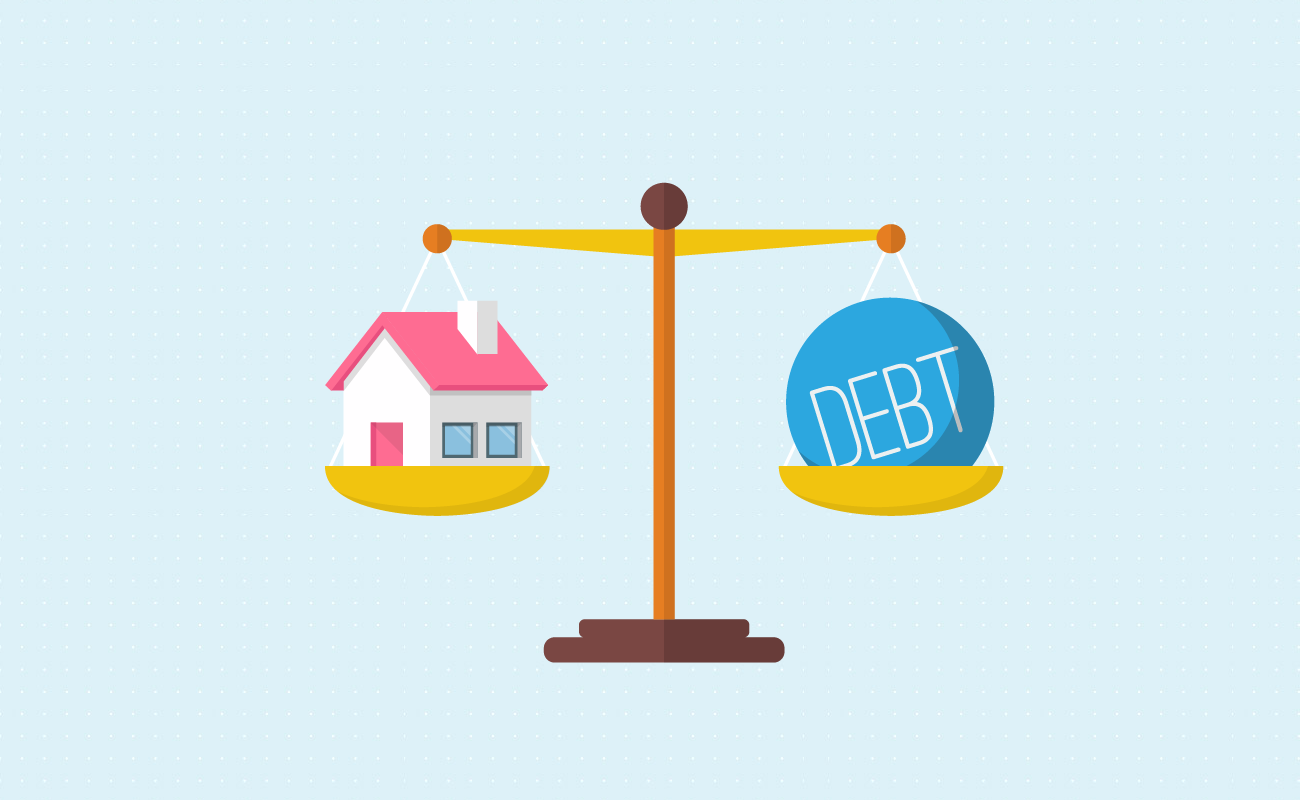Fixed Rates
30 yr
25 yr
20 yr
15 yr
10 yr
Compare Terms
Compare Rates
Real APR
Adjustable Rates
Qualification
Affordability
Renter Affordability
Rent vs Buy
Price per Square Foot
Jumbo
Home Sellers
 Debt to Income Ratio Calculator
Debt to Income Ratio CalculatorUse this calculator to determine your front end and back end debt to income ratios. The front end ratio measures the ratio of your income which is devoted to housing-related expenses. The backend ratio adds your other monthly debt obligations to the front end ratio. Generally speaking, lenders prefer borrowers who have a frontend DTI of 28% or below & a backend DTI of 36% or below. Borrowers above these levels may still qualify for lending but at higher interest rates.
Guide published by Jose Abuyuan on September 4, 2020

Life’s big milestones don’t come cheap. Owning a car, buying your ideal home, or opening your dream business all come with steep price tags. Rarely do we have enough money to pay for these out of pocket, and saving up for them takes too long. Thus, we turn to borrowed funds from lenders to make these a reality.
Of course, before we can borrow money, we must first figure out if we can afford it. Adding debts can strain your finances, especially if you’re already paying for other things. The painful lessons of the past have made creditors very wary of a person’s ability to pay. To improve your chances of getting your loan approved, you’ll need to prove that you can repay your debt.
Creditors use several indicators to gauge your ability to pay back debt. One of the most important is your debt-to-income (DTI) ratio.
Your DTI ratio represents the proportion of your debts relative to your gross income. Although described as a ratio, this is often expressed as a percentage. It measures how much of your income goes toward paying off debt. Lenders perceive this as a critical factor in your ability to pay back loans. The higher your DTI ratio, the less room you have left to pay for more debts without a hitch. Taking on too many debts too fast will put your finances into jeopardy.
You shouldn’t mistake your DTI ratio for your cash flow, which is how much money is moving in and out of your income. The expenses that are part of your DTI must be recurring and constant. These all have a required minimum amount that you must pay each month. Thus, not all your expenses are incorporated into your DTI. Everyday expenses and utilities for instance, fall out of this umbrella. Because they are subject to further deductions, taxes are also not counted.
Lenders often look at your DTI ratio to determine whether you can borrow money at all. And with good reason, too. If your DTI ratio is too high, you don’t have a lot of wiggle room for any more debt. Studies show that people with higher DTI ratios are more likely to default on their mortgages.

Don’t be sore if you still didn’t get approved. You can always improve your DTI ratio by paying off your debts first.
As useful as your DTI is as a measure, it has its limits. First of all, its picture is incomplete. It does not incorporate your taxes, for starters. Because it also focuses on minimum payments, it wouldn’t be an accurate reflection of how much you spend paying down debts. Moreover, because it excludes your everyday expenses, it does not closely represent your actual budget.
Not too long ago, the requirements needed to apply for mortgages were less strict. People could borrow money for homes without needing to prove that they could pay it back. This, of course, became a recipe for disaster. Less scrupulous lenders allowed people to borrow more money than they can afford. The resulting housing crash was a contributing factor to the Late 2000s Financial Crisis.
The connection between irresponsible lending and the housing crash did not go unnoticed. In the wake of the Great Recession, laws like the anti-predatory lending act were put in place. Lenders were no longer allowed to sign mortgages without confirming the borrower’s ability to repay. This also made it more difficult for people to qualify even for subprime mortgages.

Your DTI ratio is one of many measures used to analyze your risk as a borrower. Lenders rely on measures like these to ascertain whether you can afford to pay. Institutional lenders prefer less risky borrowers. These are people who are likely to make consistent regular payments over the long term. It isn’t enough that the borrower meets a specific income level. They also need to prove that they can pay in a consistent manner.
Lender confidence is pivotal to securing the best loan you can afford. Some lenders will not extend any money at all if you seem too risky. Other times, they won’t grant the high amount you need. This can quickly put a damper to your plans to buy a home. Thus, winning the confidence of your lender is the key to saving money when borrowing.
As of 2020, new rules make confirming your DTI ratio more critical for lenders. The Consumer Financial Protection Bureau proposed a new category of seasoned qualified mortgages. To qualify, fixed-rate mortgages must meet specific requirements over a 36-month seasoning period. Among these is that lenders verify the borrower’s DTI ratio or residual income at the point of origination.
Interest is the fee you pay your lender for borrowing their money. There are several formulas for calculating interest, depending on the type of loan. All of them, however, follow the same basic pattern. Your interest will be based on the following variables:
If you reduce any of these three elements, you incur less interest expense. Securing a good rate on the onset can save you thousands of dollars on interest payments. Once your lender is more confident in your ability to repay, they assign you a lower rate. This can be an excellent way to reduce the total costs of borrowing.
To receive a qualified mortgage, the highest possible backend DTI ratio you can have is 43 percent. Rarely will borrowers qualify for any mortgage if their ratio is higher than that, though Fannie Mae and Freddie Mac have made exceptions for borrowers who carry a high student debt load. In practice, lenders are far more strict. Most will not consider lending to anyone with a DTI ratio higher than 36 percent.
And this is just the tip of the iceberg. In practice, lenders will still consider other factors within your total DTI ratio.
The Consumer Financial Protection Bureau announced they were taking steps to address the GSE patch by submitting two Notices of Proposed Rulemaking (NPRM). One of these NPRMs covering the Government-Sponsored Enterprises (Fannie Mae and Freddie Mac) suggested shifting the ability-to-repay (ATR) requirement from the The Truth in Lending Act to focus on loan pricing instead of DTI in isolation.
“the Bureau proposes to amend the General QM definition in Regulation Z to replace the DTI limit with a price-based approach. The Bureau is proposing a price-based approach because it preliminarily concludes that a loan’s price, as measured by comparing a loan’s annual percentage rate to the average prime offer rate for a comparable transaction, is a strong indicator and more holistic and flexible measure of a consumer’s ability to repay than DTI alone. For eligibility for QM status under the General QM definition, the Bureau is proposing a price threshold for most loans as well as higher price thresholds for smaller loans, which is particularly important for manufactured housing and for minority consumers. The NPRM also proposes that lenders take into account a consumer’s income, debt, and DTI ratio or residual income and verify the consumer’s income and debts.”

Most lenders examine both front-end and back-end DTI ratios. The back-end DTI refers to the proportion of all your debts taken together. Front-end DTI ratios, meanwhile, are the sum of all your debt expenses dedicated to housing. These include rental payments, mortgage payments, mortgage insurance, and homeowner’s association dues.
The other debts in your back-end DTI are easier to manage or reduce. There are times where you can clear out your credit card bills or student loans with ample effort. Although far from easy, paying down your debts is one of the best options you can take. You may also avoid taking on more debt to keep it from getting any bigger. Your front-end DTI ratio is less flexible. It represents the amount of money you must pay to stay housed where you live at present. That is an amount that stays fixed unless you move.
Some lenders consider back-end DTI to be the most important aspect. Others prefer your front-end DTI. A few lenders may even scrutinize the type of debts in your back-end DTI ratio. You might not qualify if up to 7 percent of your DTI comprises high-interest credit card bills.
The maximum back-end DTI ratio limit for qualified conventional mortgages is 43 percent. Meanwhile, 28 percent is the maximum front-end DTI ratio needed to qualify for a mortgage. Many lenders prefer applicants who have DTI ratios much lower than that. In general, the lower your DTI ratio, the better your chances of mortgage approval.
The expenses included in your frontend DTI are:
You derive your frontend DTI ratio by dividing your monthly housing expenses by your monthly (gross) income. To get the percentage, you multiply the quotient by 100.
Frontent DTI = Housing Expenses / Income x 100
For example, let’s assume you make $9,000 gross per month. Your total housing expenses amount to $2,000. Here’s what your DTI ratio would be:
Expenses included in your backend DTI calculations are:
You derive your backend DTI ratio by dividing your monthly housing expenses and other debt obligations by your monthly (gross) income. To get the percentage, you multiply the quotient by 100.
Backend DTI = Total Debts / Income x 100
For example, let’s assume you make $9,000 gross per month. Your total debts, including your rent payments, amount to $3,200. Here’s what your DTI ratio would be:
The maximum DTI ratios will also vary between the types of mortgage you apply for:
| Loan Type | Maximum Front-end DTI | Maximum Back-end DTI |
|---|---|---|
| Conventional | 28% | 43% (36% preferred) |
| Federal Housing Authority (FHA) | 31% | 43% |
| Veterans Affairs* (VA) | – | 41% |
| Department of Agriculture (USDA) | 29% | 41% |
| Jumbo | 28% | 43% (36% preferred) |
*Veterans Affairs mortgages base their applicability solely on back-end DTI ratios.
Of course, these rules are not set in stone. Some lenders might be flexible enough to give you a bit of leeway for much higher DTI ratios. If you have a sterling credit score (i.e. a FICO score of 800 and above), your lender might be more lenient with their limits. Automated mortgage approvals also have a higher likelihood of approving loans for people with higher DTI ratios.

There is a caveat when you get a mortgage despite having a high DTI ratio. Your lender will likely give you a higher interest rate. This represents a missed opportunity for you. People with excellent credit scores usually qualify for lower interest rates. In that case, it might be better to lower your DTI ratio before applying for a mortgage.
For our example, let’s assume that you earn around $4,500 a month and your spouse’s take-home pay amounts to $4,000. You also drive for Uber on weekends, earning an extra $572 each month. You’ve decided to buy a new home to accommodate your growing family. But can your budget afford it? Let’s look at your cash inflow:
| Income Source | Monthly Value |
|---|---|
| Gross Pay | $4,500.00 |
| Spouse’s Take-Home Pay | $4,000.00 |
| Extra income (Uber Driving) | $572.00 |
Your cumulative cash flow would be around $9,072. Meanwhile, here’s a breakdown of your typical monthly debt expenses:
| Debt | Monthly Cost |
|---|---|
| Mortgage | $1,000.00 |
| Property Taxes | $200.00 |
| Homeowners Insurance | $100.00 |
| Student Loans | $964.00 |
| Car Loans | $754.00 |
| Minimum Credit Card Payments | $140.00 |
Let’s look at how it translates to your respective DTI ratios:
| Expense Type | Amount | DTI Ratio |
|---|---|---|
| Homeownership Expenses | $1,300.00 | 14.33% Front-end |
| Total Monthly Payments | $3,104.00 | 34.22% Back-end |
With these ratios, you and your spouse have a good chance at having your mortgage approved. Combine that with a sterling credit score and you can receive good rates as well.
The best way to improve your DTI ratio is through managing and reducing debt. Although not as easy as it sounds, it is well worth it. A concerted effort to clear off your debt burdens should come before getting a mortgage.
When formulating a strategy for debt management, find a debt to focus on. High-interest consumer debts like credit cards should be first on the chopping block. As mentioned earlier, high credit card bills are a red flag for most lenders, and with good reason. Left to themselves, credit card debt can balloon out of proportion rather fast.
Having fewer debts benefits your finances in many ways. You gain the peace of mind knowing that your debts won’t become a problem in the future. You will also bolster your cash flow, which can help you meet your financial objectives. It’ll be easier to aim for a larger down payment if you have more money coming in. Moreover, clearing off your debts can be good for your credit score. This can help you qualify for mortgages with lower interest rates.
If you have too many high-interest debts, consider consolidating them. Debt consolidation involves taking out a new loan to pay off many debts at once. This can simplify your debt elimination strategy by making repayment much easier to keep track.
Debt consolidation lowers your DTI ratio immediately because you make only one payment. By uniting your debts under a larger one, you save money on interest payments. The savings are especially noticeable if you consolidate them into a much lower rate. And because you’re only making one payment, you’ve freed up some more cash. Through extra payments, you can even pay them off faster and save money on interest.
It does have a major drawback. Consolidation has a negative effect on your credit score. Most people only consolidate their debts if they feel that having several at a time is too troublesome. Thus, many lenders also perceive them as higher-risk. If you want to preserve your credit score, try paying off your debts one by one instead.

If you already bought a house, you might be tempted to clear your other debts through cash-out refinancing. This involves replacing your current mortgage with a larger loan including what you currently owe on the house and enough to cover your other debts. The difference is given to you as cash, which you can use to pay off debts. Although you can quickly remove your other debt payments, you also increase your monthly mortgage payments and put your house on the line.

Even if you can pay off your consumer debts fast, their effects on your DTI ratio might not be enough. You might be stuck with other debts that take years to clear, or live in a high-rent area. These intervening circumstances might make it difficult to bring down your DTI ratio. In other times, you won’t be able to lower it fast enough to take advantage of lower rates or lower prices. This represents your last hurdle toward affording a house.
When opportunity cost is on the line, you must consider all the options at your disposal. In these cases, you can get a cosigner for your mortgage. The cosigner agrees to pay your mortgage in the event that you cannot. By sharing the responsibility of your mortgage with someone else, you are seen as less risky by your lender.
Getting a cosigner might be the better deal if you don’t quite qualify on paper but can afford a monthly mortgage. After all, there’s only so much you can do to improve your financial metrics on short notice. Your extra money might instead serve you better going toward a larger down payment.
Your choice of cosigner matters. Besides having a stable income, your cosigner should also have a good credit history. The better your cosigner looks to your lenders, the greater your chances of getting approved. The cosigner you choose must also be trustworthy. After all, they’ll be having your back when you somehow can’t pay your mortgage.
Your DTI ratio is the linchpin for most of your major financial decisions. Thus, lowering it must be a priority. This has a multitude of benefits besides improving your chances of loan approval. Having fewer debts translate to greater cash flow. This can help you bolster your savings for down payments, emergencies, and retirement. In addition, lowering your debts also improves your credit score.
As important as it is, your DTI ratio is not the only factor when considering a mortgage. You’ll need to reduce your debts to win your lender’s confidence. Examine your budget with care and make sure you know where your money is going. You might find that your budget is much lower than your current DTI ratio would lead you to think.
Furthermore,you can cement your lender’s confidence by staying in your job long-term. The longer you’re on board in your current company, the more stable you appear to your potential lenders. You can also work toward increasing your cash flow through side gigs.
Want to plan your way to a debt-free life? Check out our guide on our debt payoff goal calculator.
Jose Abuyuan is a web content writer, fictionist, and digital artist hailing from Las Piñas City. He is a graduate of Communication and Media Studies at San Beda College Alabang, who took his internship in the weekly news magazine the Philippines Graphic. He has authored works professionally for over a decade.